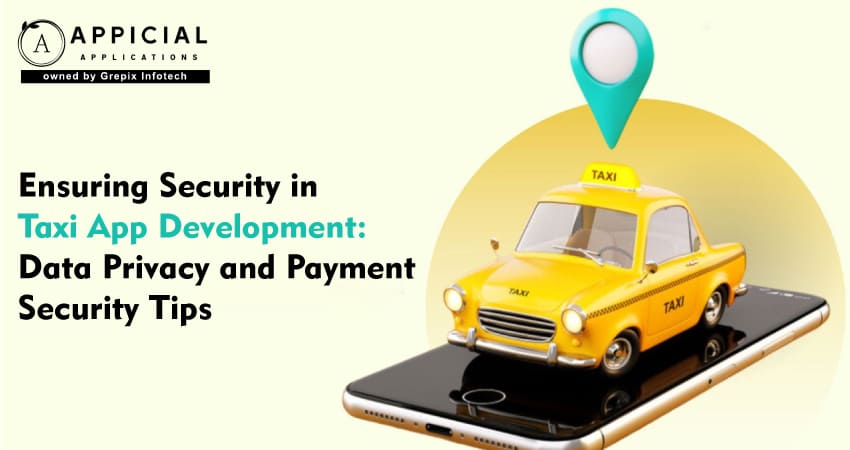
Ensuring Security in Taxi App Development: Data Privacy and Payment Security Tips
Imagine this: a young professional hails a taxi through an app after a long day, trusting the platform to get home safely. Behind this simple tap lies a complex web of sensitive personal data, payment details, and live location tracking, all of which need to be secured from prying eyes. Taxi app development isn’t just about providing seamless rides; it’s about creating a safe, privacy-focused, and secure environment for passengers and drivers in a world where data breaches and payment fraud are daily news.
In today’s digital-first landscape, ensuring the security of a taxi app is more than a technical requirement; it is a business imperative to build trust, protect brand reputation, and comply with global regulations.
Let’s break down how you can transform your taxi app into a fortress of privacy and payment security.
Ensuring security in taxi app development is essential for protecting user data and creating a trustworthy platform. With sensitive personal and financial information, taxi apps must address security from multiple angles, including data privacy, secure payment processing, and robust authentication methods. Implementing privacy-compliant frameworks, encryption, multi-factor authentication, and fraud detection helps safeguard both driver and passenger information. This guide provides an in-depth look at securing taxi apps, covering data encryption, regulatory compliance, incident response planning, and Appicial Applications’ expertise in integrating these measures for a secure, reliable user experience in today’s competitive market.
1The Importance of Security in Taxi Apps
Taxi apps, like many digital platforms, face potential risks from data breaches, identity theft, and payment fraud. Users entrust these platforms with sensitive data such as personal identification information (PII), payment details, and real-time location. Compromises in security can lead to financial loss, reputational damage, and decreased customer trust. Building robust security frameworks is, therefore, essential for a secure and successful taxi app.
2Data Privacy in Taxi Apps
Data privacy encompasses the measures taken to safeguard personal information collected by the app. Protecting this data is critical to meet regulatory standards, maintain user trust, and ensure compliance with privacy laws.
Key Privacy Regulations to Consider
- GDPR (General Data Protection Regulation): This EU regulation requires companies to obtain user consent before collecting personal data and mandates that data be handled securely and transparently.
- CCPA (California Consumer Privacy Act): CCPA grants users rights over their data, including the right to know what data is collected, delete data, and opt out of data sales.
- HIPAA (Health Insurance Portability and Accountability Act): Although generally relevant to health information, HIPAA could apply to taxi apps if they partner with health services for patient transport.
Data Collection and Privacy by Design
- Data Minimization: Limit the data collected to what’s strictly necessary for app functionality, reducing risk exposure in the event of a breach.
- User Consent and Transparency: To avoid common security flaws like SQL injection and cross-site scripting (XSS), make sure that every user input is verified and cleaned. Implement clear and concise privacy policies.
- Access Control and Authentication: Use role-based access controls (RBAC) and multi-factor authentication (MFA) to restrict access to sensitive data and reduce the risk of unauthorized access.
Data Anonymization and Encryption
- Data Anonymization: Remove identifying information from datasets to protect privacy, especially when sharing data with third parties or for analytical purposes.
- Data Encryption: Encrypt data both in transit (SSL/TLS protocols) and at rest (AES or RSA encryption standards) to ensure that data remains protected from unauthorized access.
Also Read: 1Taxi Clone: Revolutionizing Taxi Booking App Development in Spain
3 Secure Payment Processing
An essential component of a taxi app is a secure payment processing system, which protects users' financial data. Ensuring payment security protects against fraud, builds customer trust, and meets industry compliance standards.
Key Elements of Payment Security
- PCI-DSS Compliance: Payment Card Industry Data Security Standard (PCI-DSS) compliance is mandatory for any app that processes credit card transactions. Adherence to PCI-DSS ensures secure handling, transmission, and storage of payment data.
- Tokenization of Card Information: Replace sensitive card data with unique tokens during transactions, making data meaningless if intercepted.
- Secure Payment Gateways: Employ trustworthy, secure payment processors like PayPal, Braintree, or Stripe to manage sensitive credit card information safely and streamline your app's PCI-DSS compliance.
- Encryption of Payment Information: Encrypt payment details during transmission to prevent data interception and ensure that only authorized parties can access financial data.
4 Two-factor Authentication for Transactions
Implementing two-factor authentication (2FA) for transactions provides an extra security layer. Users authenticate payments using a password and a second factor, such as a one-time code sent via SMS or email. This reduces the risk of fraudulent transactions even if payment details are compromised.
Fraud Detection and Prevention
- Behavioral Analysis: Analyze unusual spending patterns, sudden location changes, or rapid login attempts to detect suspicious activities.
- Machine Learning Models: Leverage machine learning algorithms to analyze transaction history, detect potential fraud, and flag high-risk transactions for further review.
- User Alerts and Notifications: Alert users of suspicious activity through app notifications, emails, or SMS, allowing users to confirm or report suspicious transactions.
5Ensuring Secure Authentication and Authorization
Authentication and authorization are the first defense against unauthorized access to sensitive user accounts and data.
Implementing Secure Authentication Methods
- Multi-Factor Authentication (MFA): Require users to verify their identity using multiple factors, such as a password and a one-time code, significantly reducing the risk of unauthorized access.
- Biometric Authentication: Leverage fingerprint or facial recognition as a secure and convenient authentication method, available on most smartphones today.
- OAuth and Single Sign-On (SSO): Use OAuth protocols to integrate third-party authentication (e.g., Google or Facebook login) securely, offering users a seamless, secure login experience.
Authorization and Access Controls
- Role-Based Access Control (RBAC): Limit access to sensitive data based on user roles (e.g., drivers vs. passengers). Only authorized personnel should have access to administrative or sensitive functions within the app.
- Session Management and Expiration: Implement automatic session timeouts and logout features to prevent unauthorized access when a user’s session is inactive.
6Location and Real-Time Tracking Security
Taxi apps rely heavily on real-time tracking and GPS data, which requires careful handling to protect user privacy and ensure data accuracy.
Location Data Privacy
- User Consent: Obtain explicit consent before collecting and using location data. Users should also have the option to opt-out or limit the app’s access to location data.
- Use of Approximate Location: Where possible, use approximate rather than precise location data to minimize privacy risks.
- Data Minimization for GPS Tracking: Restrict location tracking to when users actively use the app. To protect users' privacy, do not track their whereabouts when the app is not in use.
Securing Real-Time Tracking Data
- Encryption of Location Data: Ensure that GPS data is encrypted in transit to prevent interception by malicious actors.
- Location Spoofing Detection: Implement measures to detect and prevent location spoofing, which can be exploited for fraudulent rides or to deceive the app’s system.
- Regular Monitoring and Audits: Conduct periodic audits of location data to detect and address any anomalies or unauthorized data access.
7Protecting Driver and Passenger Data
Both drivers and passengers in a taxi app rely on secure data handling to ensure privacy, safety, and reliability. Protecting this data involves securing personal information, ride histories, and communication channels.
Driver Background Checks and Verification
- Comprehensive Background Checks: Ensure drivers undergo thorough background checks, verifying identity, driving history, and criminal records.
- Data Encryption for Background Information: Store driver background checks and personal information securely and use encryption to prevent unauthorized access.
- Privacy Protections for Drivers and Passengers: Allow drivers and passengers to use temporary numbers for communication within the app, protecting personal contact information.
Privacy-Protective Communication
- In-App Communication Only: Facilitate driver-passenger communication strictly within the app, using secure messaging and VoIP calls rather than sharing personal phone numbers.
- Data Minimization for Communication Logs: Avoid storing unnecessary details of driver-passenger communications to minimize potential privacy risks.
8Security in App Architecture and Code Development
A secure app architecture lays the foundation for long-term protection against potential vulnerabilities. Developing secure code reduces risks from the outset and helps maintain a reliable, robust app.
Secure Coding Practices
- Input Validation: Verify and clean all user input to prevent common security vulnerabilities like SQL injection and cross-site scripting (XSS).
- Use of Secure APIs: Only use secure, reputable APIs from trusted providers. Avoid exposing sensitive data in API requests or responses.
- Encryption and Data Masking in Code: Always encrypt sensitive data within the app’s code, especially hard-coded information like keys and passwords. Mask data where necessary to prevent exposure.
Regular Code Audits and Penetration Testing
- Code Audits: Regularly audit code to identify and fix vulnerabilities before they can be exploited.
- Penetration Testing: Conduct penetration tests periodically to assess the app’s security defenses and identify potential weaknesses from a third-party perspective.
- Dependency and Library Management: Use secure libraries and regularly update dependencies to avoid risks from outdated or vulnerable code.
9Ensuring Compliance with Legal and Regulatory Standards
Meeting regulatory standards is essential for protecting users and avoiding legal repercussions. Non-compliance can result in fines, penalties, and damage to the app’s reputation.
Key Compliance Areas
- GDPR and CCPA Compliance: Ensure the app meets GDPR and CCPA standards for data privacy, particularly if serving users in Europe or California.
- PCI-DSS Compliance for Payment Security: Compliance with PCI-DSS is essential for any app processing credit card payments, ensuring secure handling, storage, and transmission of payment data.
- Local Transport and Safety Regulations: In some regions, additional transport-specific regulations may apply, including driver verification, insurance requirements, and ride fare transparency.
User Rights and Data Management
- Right to Access and Delete Data: Allow users to access, download, or delete their data to comply with regulations like GDPR and CCPA.
- Transparency in Data Use: Inform users of how their data is used and ensure they can opt out of non-essential data collection.
10Continuous Monitoring and Incident Response
A strong security framework keeps an eye on the app's functionality continuously and notifies the team in real time of any potential security threats.
Continuous Security Monitoring
- Intrusion Detection Systems (IDS): Monitor network traffic and alert administrators to suspicious activity, helping to prevent data breaches.
- Anomaly Detection: Use AI and machine learning to detect unusual user behavior or suspicious patterns that could indicate fraud or unauthorized access.
- Log Management: Maintain detailed logs of user actions and access attempts for auditing and investigating potential incidents.
Incident Response Plan
- Create an Incident Response Plan (IRP): Outline steps to follow in the event of a security breach, including notifying affected users and containing the breach.
- Data Breach Notification Procedures: Provide a precise process for notifying users and regulating agencies of a data breach that conforms with all applicable laws and regulations.
- Post-Incident Analysis and Improvement: After an incident, analyze the root cause and make improvements to prevent similar events.
Conclusion
Creating a secure taxi app requires a multi-layered strategy to safeguard user information, process payments securely, and guarantee a secure ride for both drivers and passengers. From data privacy and secure payment processing to compliance and continuous monitoring, each security measure strengthens the app’s resilience against cyber threats and data breaches.
Appicial Applications, with its experience in taxi app development, can help you integrate these security measures effectively, ensuring that your app remains secure, compliant, and trusted by users. By focusing on privacy, regulatory compliance, and robust security practices, you can provide a reliable and safe platform that builds user confidence and loyalty, setting the foundation for a successful and secure taxi app in a competitive market.






